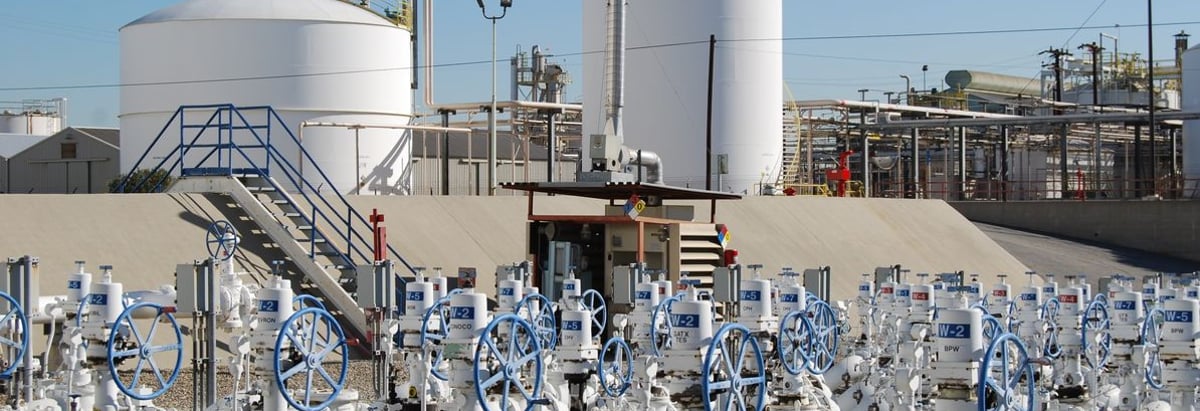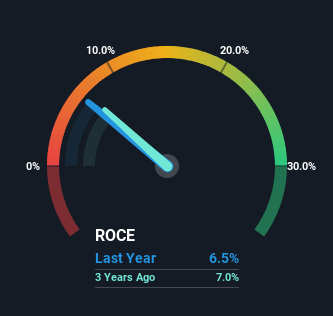
Did you know there are some financial metrics that can provide clues of a potential multi-bagger? Firstly, we'll want to see a proven return on capital employed (ROCE) that is increasing, and secondly, an expanding base of capital employed. Basically this means that a company has profitable initiatives that it can continue to reinvest in, which is a trait of a compounding machine. In light of that, when we looked at Kinder Morgan (NYSE:KMI) and its ROCE trend, we weren't exactly thrilled.
Return On Capital Employed (ROCE): What Is It?
Just to clarify if you're unsure, ROCE is a metric for evaluating how much pre-tax income (in percentage terms) a company earns on the capital invested in its business. Analysts use this formula to calculate it for Kinder Morgan:
Return on Capital Employed = Earnings Before Interest and Tax (EBIT) ÷ (Total Assets - Current Liabilities)
0.065 = US$4.3b ÷ (US$71b - US$4.7b) (Based on the trailing twelve months to September 2024).
Thus, Kinder Morgan has an ROCE of 6.5%. In absolute terms, that's a low return and it also under-performs the Oil and Gas industry average of 12%.
See our latest analysis for Kinder Morgan

Above you can see how the current ROCE for Kinder Morgan compares to its prior returns on capital, but there's only so much you can tell from the past. If you'd like to see what analysts are forecasting going forward, you should check out our free analyst report for Kinder Morgan .
How Are Returns Trending?
There hasn't been much to report for Kinder Morgan's returns and its level of capital employed because both metrics have been steady for the past five years. Businesses with these traits tend to be mature and steady operations because they're past the growth phase. So don't be surprised if Kinder Morgan doesn't end up being a multi-bagger in a few years time. That being the case, it makes sense that Kinder Morgan has been paying out 82% of its earnings to its shareholders. These mature businesses typically have reliable earnings and not many places to reinvest them, so the next best option is to put the earnings into shareholders pockets.
Our Take On Kinder Morgan's ROCE
We can conclude that in regards to Kinder Morgan's returns on capital employed and the trends, there isn't much change to report on. Although the market must be expecting these trends to improve because the stock has gained 77% over the last five years. However, unless these underlying trends turn more positive, we wouldn't get our hopes up too high.
Kinder Morgan does have some risks, we noticed 3 warning signs (and 2 which are potentially serious) we think you should know about.
While Kinder Morgan isn't earning the highest return, check out this free list of companies that are earning high returns on equity with solid balance sheets.
Valuation is complex, but we're here to simplify it.
Discover if Kinder Morgan might be undervalued or overvalued with our detailed analysis, featuring fair value estimates, potential risks, dividends, insider trades, and its financial condition.
Access Free AnalysisHave feedback on this article? Concerned about the content? Get in touch with us directly. Alternatively, email editorial-team (at) simplywallst.com.
This article by Simply Wall St is general in nature. We provide commentary based on historical data and analyst forecasts only using an unbiased methodology and our articles are not intended to be financial advice. It does not constitute a recommendation to buy or sell any stock, and does not take account of your objectives, or your financial situation. We aim to bring you long-term focused analysis driven by fundamental data. Note that our analysis may not factor in the latest price-sensitive company announcements or qualitative material. Simply Wall St has no position in any stocks mentioned.
About NYSE:KMI
Kinder Morgan
Operates as an energy infrastructure company primarily in North America.
Proven track record and slightly overvalued.
Similar Companies
Market Insights
Community Narratives



